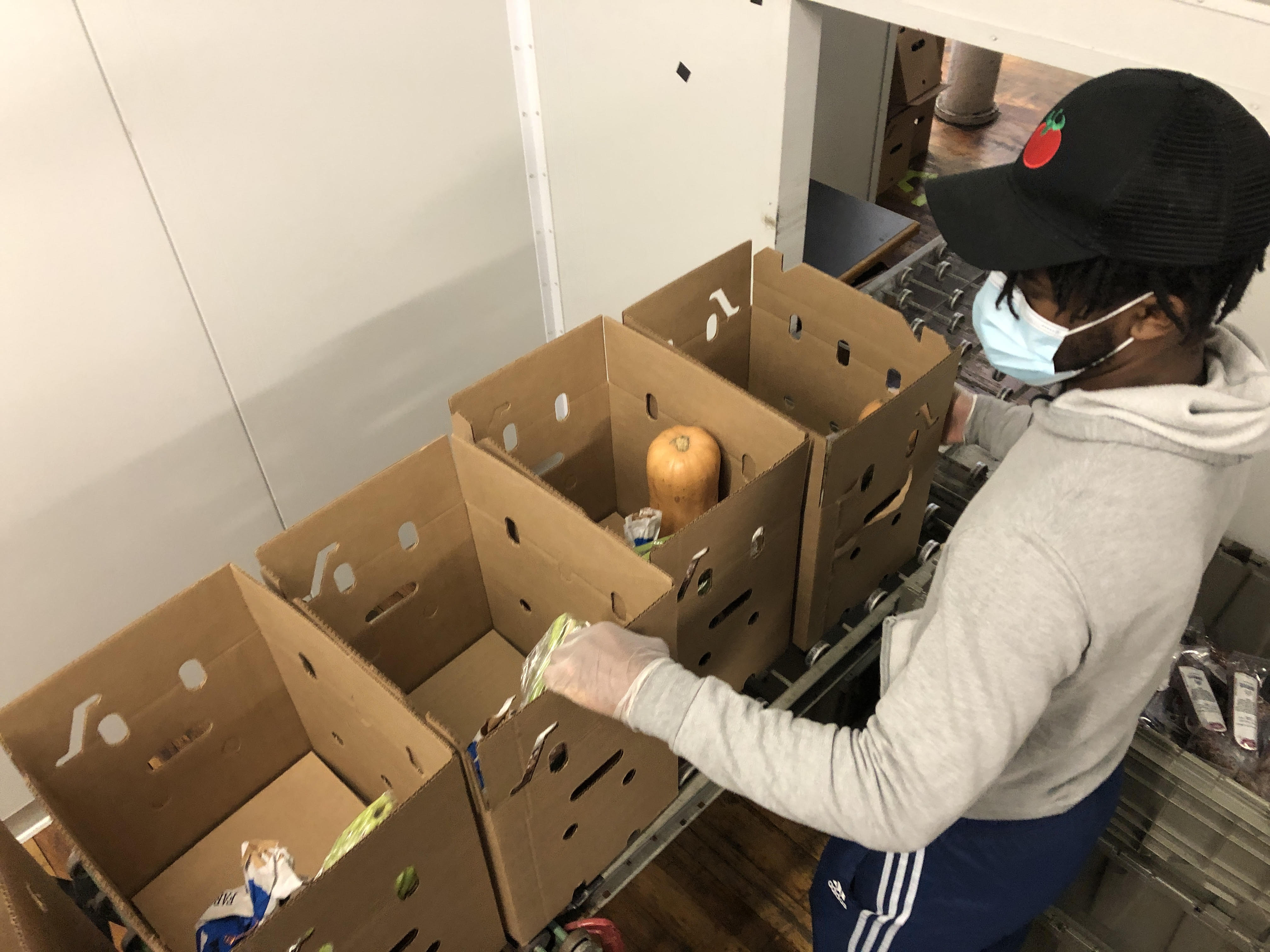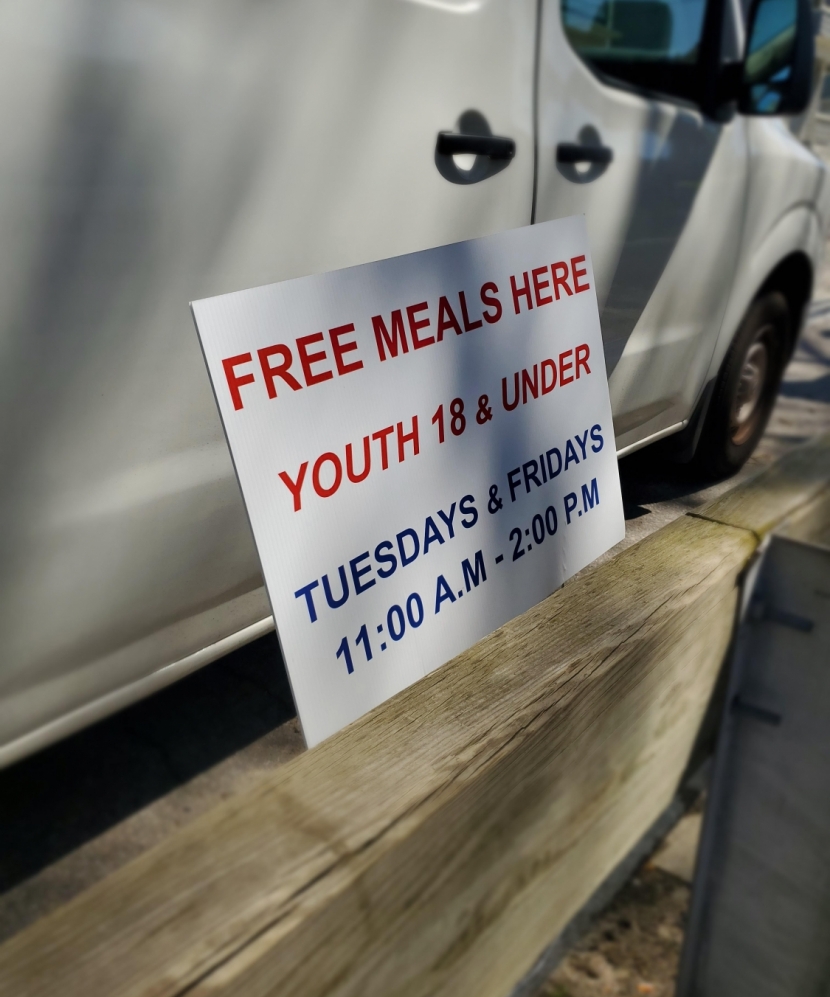What Happens When Schools Close: Creative Collaborations Sprout to Nourish Rhode Island’s Most Vulnerable Kids
The moment the state shut down back in March, everything stopped. With schools and businesses shuttered, and groceries potentially hard to find, many families with school-aged children faced a dire situation. More than 73,000 children statewide were receiving free or reduced-price meals at school, so when jobs evaporated many of these families risked going hungry without sufficient income to purchase groceries.
State agencies knew they had to step in; they collaborated remotely across departments, and with private and nonprofit organizations, to develop plans. Schools and recreation centers became grab-and-go meal sites. Students eligible for free or reduced-price lunches received pandemic debit cards, and boxes of groceries were delivered to housebound families. Private kitchens prepared meals for food pantries, universities supplied bags of fresh produce and faith-based organizations offered meal boxes to those in need.
But while these programs are responding to the Covid-19 crisis, rising food insecurity continues nationwide. New research from the Brookings Institution shows that one in five mothers with young children say their children are not getting enough to eat; nearly 35% of households with children say they lack sufficient money to get food.
“In Rhode Island last year, there were 37,402 kids in poverty. That’s 18.2%, and the highest among New England states,” says Maria Cimini, associate director of Policy Analysis, Research and Development at the Rhode Island Department of Human Services. “Moments like these really highlight the number of people left behind. Families are struggling to meet basic needs, and parents are working low-wage or sporadic jobs. Covid-19 has highlighted the community of workers who provide essential services, and many of these individuals are raising children who need [additional food assistance].”
As new initiatives still are being realized, the series of plans targeting food insecurity are growing quickly, now that hindsight shows how far Rhode Island has come in providing hungry families food options.
School Meal Site Saviors
After Rhode Island schools were closed, they reopened as takeaway meal sites and grew emboldened with their challenge to feed as many homebound families as possible. Through the Rhode Island Department of Education (RIDE) Summer Food Service Program, families with school-aged children up to age 18 are able to pick up three to four days’ worth of meals twice a week, including breakfast and lunch for each student.
Thirty-six of the state’s 39 cities and towns are now serving meals to students and their families. They had served 200,000 meals by the end of March, and as many as 900,000 through April, says Steve Carey, RIDE Child Nutrition Program coordinator.
“Families with school-age children can go to one of these sites to get a free meal,” Carey says. “Providence has a big program, as all students there automatically get free meals in school, and Central Falls, too, which has the state’s highest percentage of participation. Some school systems, including East Providence, are even delivering meals using school buses. We are trying to be as creative as possible to reach kids who can’t get to a designated site.”
While more than 143,500 students attend schools statewide, the 109 meal sites are operating at only 20% capacity, which Carey says is a small percentage of the captive audience during normal school days. “Schools have been concentrating on doing the right thing rather than worrying about financial impact down the road,” says Carey. “Just like we want to educate our kids, and ensure they have access to food, too.”
Though operating at a fraction of their potential, these sites are a lifeline for vulnerable populations. In Providence, 85% of its 24,000 students experience food insecurity at home, so there is increased participation in food programs during non-school times such as these. At its 25 meal sites, Providence had served 500,000 meals in the first six weeks of the state’s stay-at-home mandates, and served nearly 1,000,000 meals by Memorial Day.
“It was never about if we were providing meal service to kids,” says Providence Healthy Communities Director Ellen Cynar. “It was a question of how do we do it and make it better. It involves prioritizing plans, having available staff and volunteers and having healthy food sources. So, we [had to] make this happen quickly, and for a sustained period of time.”
Providence Public Schools Superintendent Harrison Peters explains that they served Grab and Go meals to about 800 students each day in mid-March. By mid-May, they were serving approximately 4,500 daily—that’s 22,500 per week—to anybody aged 18 or younger, regardless of their city of residence. Their meal service partner, Sodexo, staffs all the sites, practicing safe social distancing and food handling measures while preparing, packing and serving thousands of healthy meals, he says.
“The education of our young people does not happen in a vacuum. We know that, even before Covid-19, many of our families struggled with food insecurity,” Peters says. “A hungry student is not a focused student.”
Cynar worries that they’re not reaching enough families; some may feel awkward visiting meal sites; others physically may be unable to come; and still others might be unfamiliar with the process to accessing meal sites.
“They might think, ‘That’s not for me,’” she says. “I worry about undocumented families who … don’t feel comfortable coming out of their homes and into a public setting.”
Hopefully, home delivery tackles that issue, she says, while faith-based organizations have become a trusted community resource to those living in the shadows. But, as the state and businesses reopen this month, only time will tell how many more families and students will need these meal sites to put food on the table.
What is P-EBT?
For a hungry family, $5.70 a day—the value of the Pandemic Electronic Benefits Transfer (P-EBT) program—can be the difference between feeding their kids or going hungry. The P-EBT debit card contains the value of all the meals each public or private school student would ordinarily receive at school, if not for closures. The daily amount of $5.70 was added to existing Supplemental Nutrition Assistance Program (SNAP) cards starting April 20, or mailed to children who normally receive free or reduced-price meals.
Rhode Island was the second state to usher in this USDA plan, which augments existing SNAP benefits. P-EBT can be used to purchase groceries and food anywhere SNAP benefits are accepted, including grocery and convenience stores, farmers markets, direct purchases from some local farms and (by mid-June) from online retailers.
“Millions of American children get free and reduced-price meals at school. If their schools are closed due to Covid-19, they won’t get that nutrition, and their families might not have financial elasticity to cover the cost of those meals,” says Cimini. “So, this P-EBT program is critically important to the health of children and families while schools are closed.”
As more families have used public benefits during the pandemic because they are struggling more than normally, confusion exists about SNAP benefits and the Women, Infants and Children (WIC) program. While SNAP is available to eligible individuals and families no matter their age, WIC is a nutrition program that serves financially insecure women from pregnancy to motherhood (or for guardians) and their children ages newborn through five years. There is clientele overlap with SNAP beneficiaries, explains WIC Director Ann Barone. The grant-based WIC program is an adjunct to health care meant to improve developmental outcomes for its average monthly enrollment of 20,000 clients. Applications have grown since Covid-19, she says.
“Providing better access [for those stuck in quarantine] and availability is critical, and we’ve been able to allow that during the pandemic,” Barone says.
Grass Roots Run Deep
A crisis tests the real strength of people and organizations; in Rhode Island, we saw an early influx of donations and herculean efforts to feed families and children in need. Amid frozen budgets and soaring national unemployment rates, grassroots initiatives are helping people access food.
The Cromwell Lunch Ladies group is a fitting example. Rooms & Works, Knead Doughnuts and Providence Kitchen Collaborative teamed up to use their closed kitchens to cook nourishing packaged meals to donate to the Providence School Department. Thanks to a donation from Rooms & Works, the group prepared 500 meals initially, while a fundraiser enabled them to donate an additional 300 weekly meals for the next 10 weeks serving such to-go dishes as barbeque chicken with salad or American chop suey.
Each weekday, community and faith-based organizations deliver 600 donated meals that SnapChef assembles, while Brown University donates grocery bags packed with fresh produce twice weekly, which Cynar’s teams distribute.
A collaboration between Farm Fresh RI and RI Community Food Bank received approval for its application to the Coronavirus Food Assistance Program (CFAP) through the USDA’s Farmers to Families Food Box program. Through the collaboration, Farm Fresh RI packs 500 boxes of fresh local produce, dairy and cured meats (which will eventually increase to 3,750) each week, and the RI Community Food Bank’s member agencies distribute the boxes to needy families around the state. Not only does the food box program help feed families, it also provides income to local producers and supports the local food system.
Now, a “new normal” is in place and state programs seem to be on a roll. But with 69% of lunches served in Rhode Island public schools at free or reduced price, Cynar says the pandemic has exacerbated food insecurity, which will only become a bigger issue once the state fully reopens.
“The big question is how summer camps and enrichment programs will operate,” she says. “If we’re doing hybrid distance learning students can walk to meal sites when the weather is OK. But I’m already worried about winter, when it’s not so lovely to walk to a neighborhood school or rec center.”
###
Writing about everything from food and business to interior design and the environment in the Ocean State, Annie Sherman is a freelance journalist in Newport.
Meal sites at glance:
- Dial 211 or visit the RI Community Food Bank for local pantry information or to see how you can donate.
- See here for a list of food sites by city and town.
- See here for a map of all meal service sites statewide, including schools, rec centers and food pantries.








